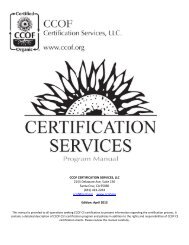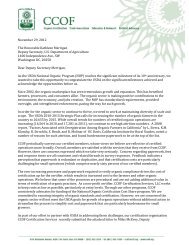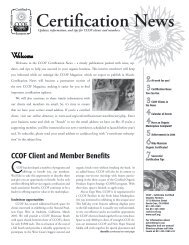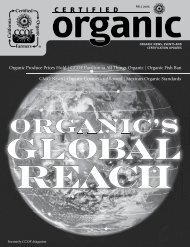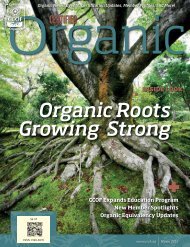HANDLER HIGHLIGHTSFINDING YOUR ORGANIC CONTROL POINTSA DAPTING H AZARD A NALYSIS AND C RITICAL CONTROL P OINTS TO YOUR O RGANIC S YSTEM P LANBy Jann<strong>in</strong>g Kennedy, Director of Handler CertificationTHE CONCEPT OF “ CRITICALcontrol po<strong>in</strong>ts,” orig<strong>in</strong>ally developedover 40 years ago to protectastronauts from microbial food contam<strong>in</strong>ation,can be used by organic processors andpost-harvest handlers to optimize their<strong>Organic</strong> System Plan. “Hazard Analysis andCritical Control Po<strong>in</strong>ts,” or “HACCP,” isnow applied not only to microbial hazardslike bacteria, but also to physical hazards, likemetal shards, and chemical hazards, like tox<strong>in</strong>s.The concepts <strong>in</strong>troduced by HACCPprotect consumers from food safety hazardsby identify<strong>in</strong>g and monitor<strong>in</strong>g critical controlpo<strong>in</strong>ts. They can be adapted by organic bus<strong>in</strong>essesto protect organic <strong>in</strong>tegrity by identify<strong>in</strong>gand monitor<strong>in</strong>g organic control po<strong>in</strong>ts(OCP). Both HACCP and OCP conceptscan be used by the entire organic food productionsystem: grow<strong>in</strong>g, harvest<strong>in</strong>g, postharvesthandl<strong>in</strong>g, process<strong>in</strong>g, packag<strong>in</strong>g,shipp<strong>in</strong>g, retail stores and food servicebus<strong>in</strong>esses.ORGANIC INTEGRITY, OCPS& ORGANIC SYSTEM PLANS<strong>Organic</strong> <strong>in</strong>tegrity can be def<strong>in</strong>ed as the qualitiesof an organic product that come fromadher<strong>in</strong>g to organic standards. <strong>Organic</strong><strong>in</strong>tegrity starts <strong>in</strong> the field and must be ma<strong>in</strong>ta<strong>in</strong>edby the food handl<strong>in</strong>g system to thepo<strong>in</strong>t of f<strong>in</strong>al sale. The concept of organic<strong>in</strong>tegrity is <strong>in</strong>cluded <strong>in</strong> National <strong>Organic</strong> Programstandards and <strong>in</strong> <strong>CCOF</strong>’s InternationalStandards, which were adopted from theAmerican <strong>Organic</strong> Standards. For example,the preamble to the National <strong>Organic</strong> Programstates, “The requirements for preventionof comm<strong>in</strong>gl<strong>in</strong>g and contact withprohibited substances, and label<strong>in</strong>g requirementsprotect the <strong>in</strong>tegrity of organically producedproducts.” An <strong>Organic</strong> System Plandescribes how a producer or processor<strong>in</strong>tends to ma<strong>in</strong>ta<strong>in</strong> organic <strong>in</strong>tegrity. Similarly,the goals of an OCP program are toidentify where organic <strong>in</strong>tegrity could becompromised, and to establish monitor<strong>in</strong>gprocedures to prevent it. A well-written<strong>Organic</strong> System Plan <strong>in</strong>cludes identificationand monitor<strong>in</strong>g of organic control po<strong>in</strong>ts,even though those terms may not be used.OCP programs can prevent costly andembarrass<strong>in</strong>g recalls and help companies producea product of the highest organic qualityand <strong>in</strong>tegrity. First we will explore how<strong>Organic</strong> Critical Control Po<strong>in</strong>ts<strong>in</strong> Food Process<strong>in</strong>gPRESENTATION AT THE 24TH ANNUAL ECO-FARM CONFERENCEASILOMAR, PACIFIC GROVE, CAFRIDAY, JANUARY 23, 2003 • WORKSHOP SESSION E, 1:30–3:30PM<strong>Organic</strong> Critical Control Po<strong>in</strong>ts analysis is an extension of Hazard Analysis and Critical ControlPo<strong>in</strong>t (HACCP) analysis that many large and small processors use to determ<strong>in</strong>e places or activitiesdur<strong>in</strong>g food process<strong>in</strong>g where food-borne illnesses could be <strong>in</strong>troduced, allow<strong>in</strong>g the implementationof control measures. This workshop will first cover the essential concepts of HACCPanalysis, and then apply these concepts to cover <strong>Organic</strong> Critical Control Po<strong>in</strong>ts.Presenters: JANNING KENNEDY, <strong>CCOF</strong>, Santa Cruz; MIKE WISE, Wiseguys Consult<strong>in</strong>g, ClovisModerator: BRIAN LEAHY, <strong>CCOF</strong> PresidentHACCP programs are set up, and then showhow OCP programs can use some of thesame pr<strong>in</strong>ciples to protect organic <strong>in</strong>tegrity.BENEFITS OF HACCP PROGRAMSHACCP programs reduce outbreaks of foodborne illnesses or <strong>in</strong>jury by emphasiz<strong>in</strong>gmonitor<strong>in</strong>g procedures and preventative measuresto prevent potential food safety hazards.HACCP has been adopted throughout thefood process<strong>in</strong>g <strong>in</strong>dustry as an exemplaryfood safety program. The USDA requiresHACCP for plants that slaughter or processmeat, poultry, or fish and for low acid canneries.Other segments of the food process<strong>in</strong>g<strong>in</strong>dustry have set up voluntary HACCP programsbecause of their proven value.HACCP programs can virtually elim<strong>in</strong>atethe need for snapshot, hit-or-miss food safety<strong>in</strong>spections and end-product test<strong>in</strong>g forpathogens or hazards. Instead, HACCP programssystematically identify the causes ofbiological or physical hazards, and monitorthose specific po<strong>in</strong>ts <strong>in</strong> the manufactur<strong>in</strong>gprocess where they can occur. When properlyimplemented, HACCP provides a record thatall reasonable precautions have been taken toprevent hazardous food from reach<strong>in</strong>g theconsumer. HACCP encourages consumerand regulatory confidence <strong>in</strong> food safety.STARTING A HACCP PROGRAMTo work well, management must be committedto the HACCP system. Company leadersmust recognize the value of deliver<strong>in</strong>g safe,high quality products, understand the pr<strong>in</strong>ciplesand practices that make it successful, andimpart that commitment to employees.Employees must recognize their role <strong>in</strong> produc<strong>in</strong>gsafe food. Only when employees aretra<strong>in</strong>ed and the program is <strong>in</strong>corporated as an<strong>in</strong>tegral part of the quality system will it betruly successful.The first step <strong>in</strong> sett<strong>in</strong>g up a HACCP programis to review the unique conditions <strong>in</strong>Page 34<strong>CCOF</strong> Magaz<strong>in</strong>e
the food process<strong>in</strong>g or handl<strong>in</strong>g facility. Theproduct is def<strong>in</strong>ed, <strong>in</strong>clud<strong>in</strong>g who consumesit, and how (for example, will it be consumedby <strong>in</strong>fants or the elderly? Will it be cooked, orfrozen, or eaten raw?). All <strong>in</strong>gredients, productionaids, and packag<strong>in</strong>g are identified.A flow diagram is developed which describesthe process. The flow diagram provides a simple,complete outl<strong>in</strong>e of the steps <strong>in</strong>volved,like receiv<strong>in</strong>g, storage, process<strong>in</strong>g, packag<strong>in</strong>g,warehous<strong>in</strong>g, and shipment. A block typeflow diagram is usually used.APPLYING HACCP PRINCIPLESOnce the product is def<strong>in</strong>ed and the flowchart written, the HACCP pr<strong>in</strong>ciples canbe applied. There are seven pr<strong>in</strong>ciples ofHACCP:1. Analyze the hazards2.Identify the critical control po<strong>in</strong>ts3. Establish critical limits4. Establish critical control po<strong>in</strong>tmonitor<strong>in</strong>g procedures5. Establish corrective actions6. Establish verification procedures7. Establish record keep<strong>in</strong>g ordocumentation proceduresIn the first step, conduct<strong>in</strong>g a hazardanalysis, the flow diagram is used to identifypotential biological, physical, and chemicalhazards. For example, salmonella, a moderate-to-seriousfood borne <strong>in</strong>fection, can becaused by <strong>in</strong>gestion of only a few cells of Salmonella.Salmonella may be identified as ahazard <strong>in</strong> a product that conta<strong>in</strong>s liquid eggs.Each hazard is assessed to determ<strong>in</strong>e itspotential severity and whether it is “reasonablylikely to occur.” Hazards that are likelyto occur are <strong>in</strong>cluded <strong>in</strong> the HACCP plan.If the potential hazard were <strong>in</strong>consequentialor not reasonably likely to occur, it would notbe <strong>in</strong>cluded.For each hazard, critical control po<strong>in</strong>ts aredeterm<strong>in</strong>ed. Critical control po<strong>in</strong>ts are thesteps at which control can be applied. Thecontrol that will be applied is essential to preventthe food safety hazard, or reduce it to anacceptable level. Examples might be cook<strong>in</strong>gor freez<strong>in</strong>g.For each critical control po<strong>in</strong>t, criticallimits must be def<strong>in</strong>ed. A critical limit is themaximum or m<strong>in</strong>imum value to which ahazard must be controlled to prevent orreduce it to an acceptable level of risk. Forexample, <strong>in</strong> a cooked food, this might be them<strong>in</strong>imum cook<strong>in</strong>g temperature and timerequired to elim<strong>in</strong>ate Salmonella. Sett<strong>in</strong>gcritical limits for food safety may <strong>in</strong>volveresearch <strong>in</strong>to scientific literature orgovernment regulations.Once critical limits are def<strong>in</strong>ed, proceduresare established to monitor the critical controlpo<strong>in</strong>ts. This might <strong>in</strong>clude determ<strong>in</strong><strong>in</strong>g howand by whom cook<strong>in</strong>g times and temperatureswill be monitored.Corrective actions are established that willbe taken when monitor<strong>in</strong>g shows the criticallimit has not been met. Corrective actions arethose that would remedy the problem. Thismight <strong>in</strong>clude reprocess<strong>in</strong>g the food or dispos<strong>in</strong>gof it if the m<strong>in</strong>imum time and temperatureswere not met. When a breach of thecritical limit is discovered, it is important todeterm<strong>in</strong>e the cause of the deviation andelim<strong>in</strong>ate it. Measures to prevent recurrencemust be established if the problem couldreoccur.Next, procedures are established to verifythe system is work<strong>in</strong>g. An example might becalibrat<strong>in</strong>g and test<strong>in</strong>g the temperature andtime recorders to verify each cook<strong>in</strong>g unit iswork<strong>in</strong>g properly, or observation of the monitor<strong>in</strong>gactivities and corrective actions to besure they are implemented properly.Record keep<strong>in</strong>g, the f<strong>in</strong>al pr<strong>in</strong>ciple, documentsthe HACCP system. Records <strong>in</strong>cludethe written HACCP plan and decision-mak<strong>in</strong>gdocuments used <strong>in</strong> its development,which justify critical limits. It <strong>in</strong>cludes actualdata collected, document<strong>in</strong>g the monitor<strong>in</strong>gof critical control po<strong>in</strong>ts and critical limits.Records of the corrective actions are necessary,such as the reason for hold<strong>in</strong>g a suspectedproduct, how and when it wasreprocessed or disposed of, and who wasresponsible. Records also <strong>in</strong>clude documentsof the verification procedures.STARTING AN OCP PROGRAMLike a HACCP program, an OCP (<strong>Organic</strong>Control Po<strong>in</strong>ts) program also requires commitmentfrom top managers to be effective.The company must communicate the importanceof ma<strong>in</strong>ta<strong>in</strong><strong>in</strong>g organic <strong>in</strong>tegrity to allemployees who handle organic products.There must be a sense of dedication throughoutthe company to produc<strong>in</strong>g organic productsthat meet the highest standards of<strong>in</strong>tegrity.To start an OCP program, a flow diagramis needed. The same one may be used as for aHACCP program, but it will be analyzed differently.Instead of food safety hazards, theflow diagram will be analyzed for organic<strong>in</strong>tegrity hazards. The three ways organic<strong>in</strong>tegrity can be compromised are throughW<strong>in</strong>ter 2003–2004 Page 35



